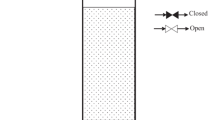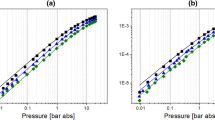Abstract
Being a discrete-continuous process, approach to a cyclic steady state in computer simulation of Pressure Swing Adsorption is through iterative procedures and simulation itself is quite computation-intensive. Considering the fact that simulation based design itself is an iterative process, it is imperative that simulation be computationally very efficient and phenomenologically as close to the physics of adsorption-desorption as possible. Utility of lumping the components of a gas mixture into fewer pseudo-components was computationally examined in the simulation of a representative multi-step cycle of a pressure swing based adsorptive separation process applied to natural gas treatment. The actual feed had six components competing for adsorbent sites. Five different lumping alternatives were studied and compared with the simulation results for a full six-component simulation under identical equipment dimensions and operating conditions. Lumping could reduce the number of equations to be solved by more than half and the corresponding reduction in CPU time was about 90%. The six component mixture of Natural Gas was found to be sufficiently represented by two pseudo-components. The predicted recovery (in terms of Methane and Ethane) and quality (in terms of content of higher hydrocarbons) of the raffinate differed by not more than 0.8% and 0.02% respectively. The paper discusses possible heuristics for decision-making regarding appropriate lumping as verified by extensive simulation studies.
Similar content being viewed by others
Abbreviations
- A :
-
Cross sectional area of the column, m2
- b i :
-
Adsorption equilibrium constant for ith component on the solid surface at the operating temperature, m3/mole
- C v :
-
Valve coefficient, dimensionless
- d p :
-
Diameter of a spherical adsorbent particle or equivalent diameter for a non-spherical particle, m
- ε :
-
External voidage in the bed packed with the adsorbent particles, dimensionless
- Φ:
-
Sphericity factor of the adsorbent particle
- dt :
-
Step size for temporal discretization, s
- dz :
-
Step size for spatial discretization, m
- L :
-
Height of the adsorbent layer packed inside the column, m
- MW i :
-
Molecular weight of ith component, kg/kmole
- P :
-
Absolute Pressure, Pa(a)
- Q Feed :
-
Volumetric feed rate of feed Natural Gas at standard conditions, m3/hr at STP conditions
- q i :
-
Average concentration of ith component adsorbed in the volume of adsorbent particles, moles/m3 solid
- q imax :
-
Maximum monolayer adsorption capacity of ith component on the adsorbent surface, moles/m3 solid
- R :
-
Ideal Gas Law constant, Pa⋅m3/mole/K
- t :
-
Temporal coordinate, s
- T :
-
Operating temperature, K
- t cycle :
-
Total cycle time, s
- t s :
-
Staggering time, s
- u :
-
Superficial velocity of the fluid, m/s
- y i :
-
Fluid phase mole fraction of ith component, dimensionless
- z :
-
Spatial coordinate, m
- C1 :
-
Methane
- C1+ :
-
Ethane and higher alkanes
- C2 :
-
Ethane
- C2+ :
-
Propane and higher alkanes
- C3 :
-
Propane
- C4’s:
-
i-Butane + n-Butane
- CSS:
-
Cyclic steady state
- IAST:
-
Ideal Adsorbed Solution Theory
- i-C4 :
-
i-Butane or Isobutane
- g :
-
Gas phase
- l :
-
Liquid phase
- N B :
-
Number of Beds
- n-C4 :
-
n-Butane or Normal Butane
- N max :
-
Maximum number of components in the system
- N PC :
-
Number of pseudo-components
- N r :
-
Number of lumping rules applied
- N s :
-
Number of steps in the cycle
- PSA:
-
Pressure Swing Adsorption
- PVSA:
-
Pressure Vacuum Swing Adsorption
- scf :
-
Supercritical fluid phase
- SCMPH:
-
Standard cubic metres per hour
- SMB:
-
Simulated Moving Bed
- STP:
-
Standard Conditions of Temperature and Pressure, 105 Pa absolute and 273.15 K
- TSA:
-
Temperature Swing Adsorption
- VSA:
-
Vacuum Swing Adsorption
References
Annesini, M.A., Giona, M., Gironi, F.: Continuous model for complex mixture adsorption. Ind. Eng. Chem. Res. 33, 2764–2770 (1994)
Aris, A.: Reactions in continuous mixtures. AIChE J. 35, 539–548 (1989)
Aris, R., Gavalas, G.R.: On the theory of reactions in continuous mixtures. Philos. Trans. R. Soc. Lond. Ser. A, Math. Phys. Sci. 260, 351–393 (1966)
Brown, A.S., Milton, M.J.T., Vargha, G.M., Mounce, R., Cowper, C.J., Stokes, A.M.V., Benton, A.J., Lander, D.F., Ridge, A., Laughton, A.P.: Measurement of the hydrocarbon dew point of real and synthetic natural gas mixtures by direct and indirect methods. Energy Fuels 23, 1640–1650 (2009)
Calligaris, M.B., Tien, C.: Species grouping in multicomponent adsorption calculations. Can. J. Chem. Eng. 60, 772–780 (1982)
Ceresi, J.E., Tien, C.: Carbon adsorption of phenol from aqueous solutions in the presence of other adsorbates. Sep. Technol. 1, 273–281 (1991)
Chang, D., Min, J., Moon, K., Park, Y.K., Jeon, J.K., Ihm, S.K.: Robust numerical simulation of pressure swing adsorption process with strong adsorbate CO2. Chem. Eng. Sci. 59, 2715–2725 (2004)
Chihara, K., Suzuki, M.: Air drying by pressure swing adsorption. J. Chem. Eng. Jpn. 16, 293–299 (1983)
Chou, G.F., Prausnitz, J.M.: Adiabatic flash calculations for continuous or semicontinuous mixtures using an equation of state. Fluid Phase Equilib. 30, 75–82 (1986)
Cruz, P., Magalhães, F.D., Mendes, A.: On the optimization of cyclic adsorption separation processes. AIChE J. 51, 1377–1395 (2005)
Daiminger, U., Lind, W., Mitariten, M.J.: Adsorption added value. Hydrocarb. Eng. 2, 83–86 (2006)
El-Hawary, M.S., Landrigan, J.K.: Optimum operation of fixed-head hydro-thermal electric power systems: Powell’s hybrid method versus Newton-Raphson method. IEEE Trans. Power Appar. Syst. 101, 547–554 (1982)
Glinos, K., Malone, M.F.: Minimum reflux, product distribution, and lumping rules for multicomponent distillation. Ind. Eng. Chem. Process Des. Dev. 23, 764–768 (1984)
Harlick, P.J.E., Tezel, H.F.: An experimental adsorbent screening study for CO2 removal from N2. Microporous Mesoporous Mater. 76, 71–79 (2004)
Holcombe, T.C., Sager, T.C., Volles, W.K., Zarchy, A.S.: Isomerization process. US Patent 4,929,799 (1990)
Jacome, P.A.D., Peixoto, F.C., Platt, G.M., Ahon, V.R.R.: A new approach to distillation of continuous mixtures: modelling and simulation. Lat. Am. Appl. Res. 35, 233–239 (2005)
Jee, J.G., Kim, M.B., Lee, C.H.: Adsorption characteristics of hydrogen mixtures in a layered bed: binary, ternary, and five-component mixtures. Ind. Eng. Chem. Res. 40, 868–878 (2001)
Ko, D., Siriwardane, R., Biegler, L.T.: Optimization of pressure swing adsorption and fractionated vacuum pressure swing adsorption processes for CO2 capture. Ind. Eng. Chem. Res. 44, 8084–8094 (2005)
Lee, C.H., Yang, J., Ahn, H.: Effects of carbon-to-zeolite ratio on layered bed H2 PSA for coke oven gas. AIChE J. 45, 535–545 (1999)
Li, G., Xiao, P., Webley, P.A., Zhang, J., Singh, R.: Competition of CO2/H2O in adsorption based CO2 capture. Energy Procedia 1, 1123–1130 (2009)
Li, P., Tezel, H.F.: Equilibrium and kinetic analysis of CO2–N2 adsorption separation by concentration pulse chromatography. J. Colloid Interface Sci. 313, 12–17 (2007)
Liu, Y., Delgado, J., Ritter, J.A.: Comparison of finite difference techniques for simulating pressure swing adsorption. Adsorption 4, 337–344 (1998)
Malek, A., Farooq, S.: Kinetics of hydrocarbon adsorption on activated carbon and silica gel. AIChE J. 43, 761–776 (1997)
Maurer, R.T.: Methane purification by pressure swing adsorption. US Patent 5,171,333 (1992)
Mazzotti, M., Baciocchi, R., Storti, G., Morbidelli, M.: Vapor-phase SMB adsorptive separation of linear/nonlinear paraffins. Ind. Eng. Chem. Res. 35, 2313–2321 (1996)
Mehrotra, A.K., Tien, C.: Further work in species grouping in multicomponent adsorption calculation. Can. J. Chem. Eng. 62, 632–643 (1984)
Mello, M., Eic, M.: Adsorption of sulfur dioxide from pseudo binary mixtures on hydrophobic zeolites: modelling of the breakthrough curves. Adsorption 8, 279–289 (2002)
Minceva, M., Rodrigues, A.E.: Modeling and simulation of a simulated moving bed for the separation of p-xylene. Ind. Eng. Chem. Res. 41, 3454–3461 (2002)
Minceva, M., Rodrigues, A.E.: Understanding and revamping of industrial scale SMB units for p-xylene separation. AIChE J. 53, 138–149 (2007)
Minkkinen, A., Mank, L., Jullian, S.: Process for the isomerization of C5/C6 normal paraffins with recycling of normal paraffins. US Patent 5,233,120 (1993)
Nilchan, S., Pantelides, C.C.: On the optimization of periodic adsorption processes. Adsorption 4, 113–147 (1998)
Olivier, M.G., Jadot, R.: Adsorption of light hydrocarbons and carbon dioxide on silica gel. J. Chem. Eng. Data 42, 230–233 (1997)
Park, J.H., Kim, J.N., Cho, S.H.: Performance analysis of four-bed H2 PSA process using layered beds. AIChE J. 46, 790–802 (2000)
Ramaswami, S., Tien, C.: Simplification of multicomponent fixed-bed adsorption calculations by species grouping. Ind. Eng. Chem. Process Des. Dev. 25, 133–139 (1986)
Rege, S.U., Yang, R.T.: A novel FTIR method for studying mixed gas adsorption at low concentrations: H2O and CO2 on NaX zeolite and γ-alumina. Chem. Eng. Sci. 56, 3781–3796 (2001)
Rege, S.U., Yang, R.T., Qian, K., Buzanowski, M.A.: Air-prepurification by pressure swing adsorption using single/layered beds. Chem. Eng. Sci. 56, 2745–2759 (2001)
Reverchon, E., Lamberti, G., Subra, P.: Modelling and simulation of the supercritical adsorption of complex terpene mixtures. Chem. Eng. Sci. 53, 3537–3544 (1998)
Reynolds, S.P., Ebner, A.D., Ritter, J.A.: New pressure swing adsorption cycles for carbon dioxide sequestration. Adsorption 11, 531–536 (2005)
Ribeiro, A.M., Grande, C.A., Lopes, F.V.S., Loureiro, J.M., Rodrigues, A.E.: A parametric study of layered bed PSA for hydrogen purification. Chem. Eng. Sci. 63, 5258–5873 (2008)
Robben, M.A., O’Brien, D.: The case for silica. Hydrocarb. Eng. 8, 23–28 (2005)
Silva, J.A.C., Rodrigues, A.E.: Separation of n/iso-paraffins mixtures by pressure swing adsorption. Sep. Purif. Technol. 13, 195–208 (1998)
Silva, J.A.C., Da Silva, F.A., Rodrigues, A.E.: Separation of n/iso paraffins by PSA. Sep. Purif. Technol. 20, 97–110 (2000)
Sircar, S.: Basic research needs for design of adsorptive gas separation processes. Ind. Eng. Chem. Res. 45, 5435–5448 (2006)
Sircar, S., Golden, T.C.: Purification of hydrogen by pressure swing adsorption. Sep. Sci. Technol. 35, 667–687 (2000)
Sircar, S., Hufton, J.R.: Why does the linear driving force model for adsorption kinetics work? Adsorption 6, 137–147 (2002)
Sun, L.M., Quere, P.L., Levan, M.D.: Numerical simulation of diffusion-limited PSA process models by finite difference methods. Chem. Eng. Sci. 51, 5341–5352 (1996)
Yang, J., Lee, C.H.: Adsorption dynamics of a layered bed PSA for H2 recovery from coke oven gas. AIChE J. 5, 1325–1334 (1998)
Zhang, J., Webley, P.A., Xiao, P.: Effect of process parameters on power requirements of vacuum swing adsorption technology for CO2 capture from flue gas. Energy Convers. Manag. 49, 346–356 (2008)
Zhang, J., Xiao, P., Li, G., Webley, P.A.: Effect of flue gas impurities on CO2 capture performance from flue gas at coal-fired power stations by vacuum swing adsorption. Energy Procedia 1, 1115–1122 (2009)
Author information
Authors and Affiliations
Corresponding author
Rights and permissions
About this article
Cite this article
Mhaskar, P.R., Moharir, A.S. Multi-component adsorptive separation: use of lumping in PSA process simulation. Adsorption 17, 701–721 (2011). https://doi.org/10.1007/s10450-011-9355-1
Received:
Accepted:
Published:
Issue Date:
DOI: https://doi.org/10.1007/s10450-011-9355-1




